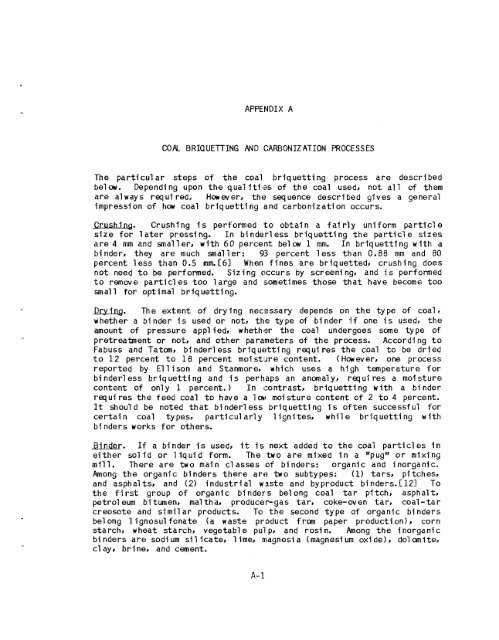Prospects for Coal Briquettes as a Substitute Fuel for Wood and ...
Prospects for Coal Briquettes as a Substitute Fuel for Wood and ...
Prospects for Coal Briquettes as a Substitute Fuel for Wood and ...
Create successful ePaper yourself
Turn your PDF publications into a flip-book with our unique Google optimized e-Paper software.
i<br />
APPENDIX A<br />
COAL BRIQUETTING AND CARE3ONIZATION IPROCESSES<br />
The particul ar steps of the coal briquetting process are described<br />
below. Depending upon the qual ities of the coal used, not all of them<br />
are always required. Howeverr the sequence described gives a general<br />
impression of how coal briquetting <strong>and</strong> carbonization occurs.<br />
JXE&LKQ* Crushing fs per<strong>for</strong>med to obtain a fairly uni<strong>for</strong>m particle<br />
size <strong>for</strong> 1 ater pressing. In bi nderl ess briquettl ng the particl e sizes<br />
are 4 mm <strong>and</strong> Smaller, with 60 percent below 1 mm. In briquetting with a<br />
binder, they are much smaller: 93 percent less than 0.88 nm <strong>and</strong> 80<br />
percent less than 0.5 mmC61 When fines are briquetted, crushing does<br />
not need to be per<strong>for</strong>med. Sizing occurs by screening? <strong>and</strong> is per<strong>for</strong>med<br />
to remove particles too large <strong>and</strong> sometimes those that have become too<br />
small <strong>for</strong> optimal briquetting.<br />
Drying. The extent of drying nemssary depends on the type of coalr<br />
whether a binder is used or not, the type of binder -If one is used, the<br />
amount of pressure applied, whether the coal undergoes some type of<br />
pretreatment or not, <strong>and</strong> other parameters of the process. According to<br />
Fabuss <strong>and</strong> Tatcan* binderless briquetting requires the coal to be dried<br />
to 12 percent to 18 percent moistiJre content. (However, one process<br />
reported by Ellison <strong>and</strong> Stanmore, which uses a hlgh temperature <strong>for</strong><br />
bi nderl ess briquetting <strong>and</strong> is perhaps an anomaly, requi res a molsture<br />
content of only 1 percent.) In contr<strong>as</strong>t, briquetting with a binder<br />
rqui res the feed coal to have a lorr moisture content of 2 to 4 percent.<br />
It should be noted that bfnderless briquetting is often successful <strong>for</strong><br />
certain coal typesl particularly lignites, while briquetting with<br />
binders works <strong>for</strong> others.<br />
Binw. If a binder is used, it is next added to the coal particles in<br />
either solid or liquid <strong>for</strong>m. The two are mixed in a tcpugtt or mixing<br />
mill. There are two main cl<strong>as</strong>ses of binders: organic <strong>and</strong> inorganic,<br />
Among the organic binders there are two subtypes: (1) tars, pitches,<br />
<strong>and</strong> <strong>as</strong>phalts, <strong>and</strong> (2) Industrial w<strong>as</strong>te <strong>and</strong> byproduct binders.Cl21 To<br />
the first group of organlc binders belong coal tar pitch, <strong>as</strong>phalt,<br />
petrol eum bitumen, mal tha, producer-g<strong>as</strong> tar, coke-oven tar, coal-tar<br />
creosote <strong>and</strong> similar products. To the second type of organic binders<br />
belong 1 ignosul fonate (a w<strong>as</strong>te product f rcm paper producti on) corn<br />
starch, wheat starch, vegetable pulpr <strong>and</strong> rosin. Among the inorganic<br />
bi nders are sodi um si1 lcateJ 1 ime, niagnesi a (magnesi urn oxide) dol orniter<br />
cl ayJ brine, <strong>and</strong> cement.<br />
A- 1

















